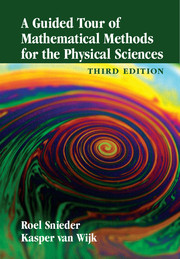Book contents
- Frontmatter
- Contents
- List of figures
- List of tables
- About the authors
- 1 Introduction
- 2 Dimensional analysis
- 3 Power series
- 4 Spherical and cylindrical coordinates
- 5 Gradient
- 6 Divergence of a vector field
- 7 Curl of a vector field
- 8 Theorem of Gauss
- 9 Theorem of Stokes
- 10 The Laplacian
- 11 Scale analysis
- 12 Linear algebra
- 13 Dirac delta function
- 14 Fourier analysis
- 15 Analytic functions
- 16 Complex integration
- 17 Green's functions: principles
- 18 Green's functions: examples
- 19 Normal modes
- 20 Potential field theory
- 21 Probability and statistics
- 22 Inverse problems
- 23 Perturbation theory
- 24 Asymptotic evaluation of integrals
- 25 Conservation laws
- 26 Cartesian tensors
- 27 Variational calculus
- 28 Epilogue, on power and knowledge
- References
- Index
1 - Introduction
Published online by Cambridge University Press: 05 March 2015
- Frontmatter
- Contents
- List of figures
- List of tables
- About the authors
- 1 Introduction
- 2 Dimensional analysis
- 3 Power series
- 4 Spherical and cylindrical coordinates
- 5 Gradient
- 6 Divergence of a vector field
- 7 Curl of a vector field
- 8 Theorem of Gauss
- 9 Theorem of Stokes
- 10 The Laplacian
- 11 Scale analysis
- 12 Linear algebra
- 13 Dirac delta function
- 14 Fourier analysis
- 15 Analytic functions
- 16 Complex integration
- 17 Green's functions: principles
- 18 Green's functions: examples
- 19 Normal modes
- 20 Potential field theory
- 21 Probability and statistics
- 22 Inverse problems
- 23 Perturbation theory
- 24 Asymptotic evaluation of integrals
- 25 Conservation laws
- 26 Cartesian tensors
- 27 Variational calculus
- 28 Epilogue, on power and knowledge
- References
- Index
Summary
The topic of this book is the application of mathematics to physical problems. Mathematics and physics are often taught separately. Despite the fact that education in physics relies on mathematics, many students consider mathematics to be disjointed from physics. Although this point of view may strictly be correct, it becomes problematic when it concerns an education in the sciences. The reason for this is that mathematics is the only language at our disposal for quantifying physical processes. Furthermore, common mathematical foundations often form the link between different topics in physics.
A language cannot be learned by just studying a textbook. In order to truly learn how to use a language, one has to go abroad and start using that language. By the same token, one cannot learn how to use mathematics in the physical sciences by just studying textbooks or attending lectures; the only way to achieve this is to venture into the unknown and apply mathematics to physical problems. The goal of this book is to do exactly that; we present exercises to apply mathematical techniques and knowledge to physical concepts. These are not presented as well-developed theory, but as a number of problems that elucidate the issues at stake. In this sense, the book offers a guided tour: material for learning is presented, but true learning will only take place by active exploration. The interplay of mathematics and physics is essential in the process; mathematics is the natural language to describe physics, while physical insight allows for a better understanding of the mathematics that is presented.
How can you use this book most efficiently?
Since this book is written as a set of problems, you may frequently want to consult other material as well to refresh or deepen your understanding of material. In many places we refer to the book by Boas (2006).
- Type
- Chapter
- Information
- Publisher: Cambridge University PressPrint publication year: 2015



